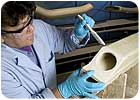ASSEMBLY END USER: Adhesive Reinforces Air Ducts
Aerospace components
manufacturer Saint-Gobain Performance Plastics (SGPPL), Seattle, has perfected
a system for producing secondary structures such as lightweight,
self-insulating air-distribution ducts and panels for aircraft using
epoxy adhesives from Huntsman Advanced Materials.

Aerospace components manufacturer Saint-Gobain Performance Plastics (SGPPL), Seattle, has perfected a system for producing secondary structures such as lightweight, self-insulating air-distribution ducts and panels for aircraft using Epibond® epoxy adhesives from Huntsman Advanced Materials.
SGPPL uses Epibond®1544-A82/D, a high-performance, self-extinguishing adhesive, to seal and reinforce the air ducts.
The epoxy adhesive is particularly suited to fabricating aircraft parts that must meet U.S. Federal Aviation Administration regulation (FAA FAR) 25.853 and O.S.U. tests (heat release rate). The product is qualified to BMS 5-126, Type 4, Class 4, Grade B.
SGPPL produces rigid foam ducts with fiberglass skins in sizes up to 3.9 m by 50 cm and panels up to 120 cm2; it is also a preferred supplier to aerospace manufacturers around the world.
SGPPL molds duct walls by casting rigid isocyanurate foam into tools lined with fiberglass material. The process produces air-distribution ducts and panels that have a fiberglass skin integrally molded into the parts, which accommodates the manufacture of a variety of complex shapes required for installation behind aircraft floors, walls, and ceilings.
To complete duct assemblies, the edges of the rigid-foam structures are sealed using fiberglass soaked with 1544-A82/D epoxy adhesive. Edge sealing helps promote long-term part durability by increasing strength and preventing moisture incursion. Seams and through-wall sections drilled for inserts are also reinforced with the fiberglass/epoxy combination.
Epibond 1544-A82/D epoxy adhesive helps optimize manufacturing productivity because it is easy to apply, has a 20-min. gel time and develops early green strength to accommodate handling of parts after four hours at room temperature. The semi-paste-like epoxy is non-flowing, even when applied to vertical surfaces, and has a density of 1.18g/cc to maintain the desired light duct weight.

Aerospace components manufacturer Saint-Gobain Performance Plastics (SGPPL), Seattle, has perfected a system for producing secondary structures such as lightweight, self-insulating air-distribution ducts and panels for aircraft using Epibond® epoxy adhesives from Huntsman Advanced Materials.
SGPPL uses Epibond®1544-A82/D, a high-performance, self-extinguishing adhesive, to seal and reinforce the air ducts.
The epoxy adhesive is particularly suited to fabricating aircraft parts that must meet U.S. Federal Aviation Administration regulation (FAA FAR) 25.853 and O.S.U. tests (heat release rate). The product is qualified to BMS 5-126, Type 4, Class 4, Grade B.
SGPPL produces rigid foam ducts with fiberglass skins in sizes up to 3.9 m by 50 cm and panels up to 120 cm2; it is also a preferred supplier to aerospace manufacturers around the world.
SGPPL molds duct walls by casting rigid isocyanurate foam into tools lined with fiberglass material. The process produces air-distribution ducts and panels that have a fiberglass skin integrally molded into the parts, which accommodates the manufacture of a variety of complex shapes required for installation behind aircraft floors, walls, and ceilings.
To complete duct assemblies, the edges of the rigid-foam structures are sealed using fiberglass soaked with 1544-A82/D epoxy adhesive. Edge sealing helps promote long-term part durability by increasing strength and preventing moisture incursion. Seams and through-wall sections drilled for inserts are also reinforced with the fiberglass/epoxy combination.
Epibond 1544-A82/D epoxy adhesive helps optimize manufacturing productivity because it is easy to apply, has a 20-min. gel time and develops early green strength to accommodate handling of parts after four hours at room temperature. The semi-paste-like epoxy is non-flowing, even when applied to vertical surfaces, and has a density of 1.18g/cc to maintain the desired light duct weight.
Once cured, the epoxy adhesive exhibits good mechanical properties with a range of substrates, including phenolics, metals and ceramics. The adhesive can be used at temperatures up to 93°C.
Looking for a reprint of this article?
From high-res PDFs to custom plaques, order your copy today!


